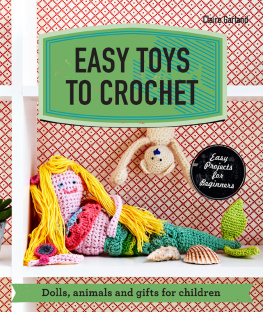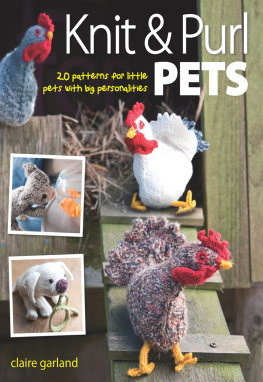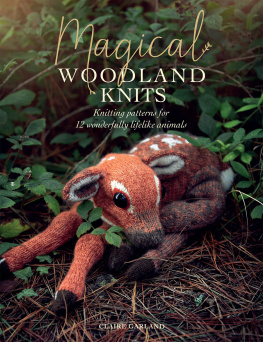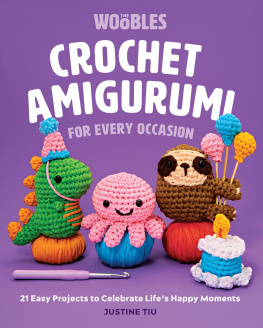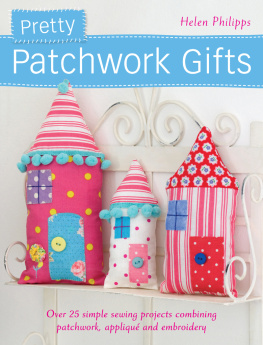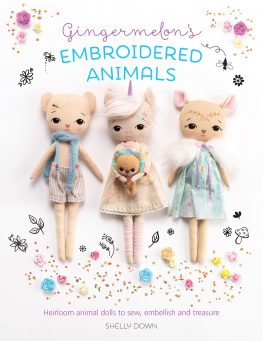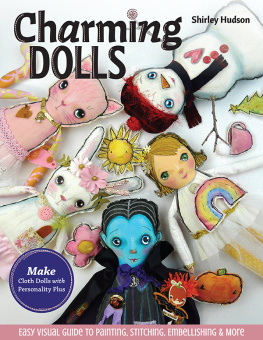EASY TOYS TO CROCHET

EASY TOYS TO CROCHET
Dolls, animals and gifts for children
Claire Garland

Contents
Introduction

Ive always found crochet to be a craft of myriad benefits. On a professional level, it is a design tool that provides ease and workability what other craft allows you to create perfect circles in a matter of a few simple knots? On a personal note, crocheting is a stress-reliever and an ideal way to unwind after a long day. With just a hook and a ball of yarn, crocheting offers an immediate sense of accomplishment and release, especially when making toys.
My creative inspiration for these projects was sparked by my children: I love the way they create miniature worlds and how their toys develop into loveable friends and cuddly beasts. My objective in this book was to devise a collection of unique and character-driven toys. The results, I hope, are fun creations that are totally endearing.
I couldnt choose a favourite from among the projects they all brim with personality, and I adore them equally. The Mermaid, with her cascading mane and long, crocheted fin, radiates beauty; the Giraffe, with her jolly scarf and dress, is a stylish creature; and Sir Waldorf Walrus is a grand old gentleman of the seas.
All the projects in this book are simple to make and require very little time to finish, which is great if you have an anxious child peering over your shoulder. (I recommend stitching up a couple of finger puppets for such an occasion!) I hope the projects in this book bring as much satisfaction to you as they did for me. I thoroughly enjoyed designing and making each toy, and I hope I have expressed this pleasure on every page.
Enjoy and get hooked!
Crochet Basics

This book is not aimed at complete beginners, although many of the projects are simple enough to tackle without much experience, and I hope they will inspire you to move on to some of the more complex toys. Below are a few useful points to bear in mind.
UK and US crochet terms
In the patterns, we give UK crochet stitch names first, with the US equivalents following, separated by a slash. If you find this confusing to follow, try photocopying the patterns you would like to make and highlighting instructions in the language you are most familiar with. Below are some of the key differences:
UK terms and US conversions
double crochet (dc) = single crochet (sc)
half treble (htr) = half double crochet (hdc)
treble (tr) = double crochet (dc)
double treble (dtr) = treble (tr)
Abbreviations
beg beginning
ch chain(s)
ch sp chain space(s)
cm centimetre(s)
cont continue
dc double crochet (NB: both UK and US term)
dc2tog double crochet two stitches together
dc3tog double crochet three stitches together
dec decrease
dtr double treble (NB: UK term only)
foll following
hdc half double crochet (NB: US term only)
htr half treble crochet (NB: UK term only)
in inch(es)
inc increase
m metre(s)
mm millimetre(s)
rem remaining
rep repeat
RS right side
sc single crochet (NB: US term only)
sl st slip st
sp space(s)
st(s) stitch(es)
tch turning chain
tog together
tr treble (NB: both UK and US term)
WS wrong side
yd yard(s)
[ ] work instructions in square brackets as directed
Yarns
Many of the projects are quite small-scale and will not require a full ball of yarn to complete, so you can take this opportunity to do some stash-busting! Many of the yarns are readily convertible to whatever you have to hand, so do not feel you need to stick rigidly to the recommended yarns. As long as you follow the suggested yarn weight, and of course keep to the tension (gauge) set out in the pattern instructions, most yarns will be suitable, whether they are pure wool, wool blends, acrylic, cotton or other blends. The only exception is where the project suggests using a textured or fluffy yarn , uses a fluffy yarn for effect.
Hook conversions
You should be aware that different parts of the crocheting world use different sizing systems for crochet hooks. In this book we list both metric sizes (the measurement is in millimetres) and US sizes the US has its own idiosyncratic sizing system.
Metric | US |
2.50 |
2.75 | C-2 |
3.00 |
3.25 | D-3 |
3.50 | E-4 |
3.75 | F-5 |
4.00 | |
4.50 | |
5.00 | H-8 |
5.50 | I-9 |
6.00 | J-10 |
6.50 | K10 |
7.00 | |
8.00 | L-12 |
9.00 | M-13 |
10.00 | N-15 |
Techniques for finishing touches
Here are some useful sewing and embroidery stitches that are used to add finishing touches to the toys.
Backstitch
Use for sewing strong seams or for attaching trims by hand. Bring the needle up from the underside of the fabric and insert it about 3mm ( in) behind the point at which the thread came out. Bring the needle out about 3mm ( in) in front of the starting point. Continue in the same manner.
French knot
Bring the needle out on the surface of the fabric at the place where the knot is to lie. Wrap the thread around the needle two or three times, depending on how big you want the knot to be. Insert the needle close to where it came out. Holding the knot in place, pull the needle to the wrong side to secure the knot.
Oversew
Sew the two edges together with close stitches that pass over them both approximately 3mm (in) from the edge of both edges.
Satin stitch
Work parallel straight stitches, close together, across the entire area of a shape to fill it.
Stem stitch
Bring the needle to the front at the left-hand side of the working line. With the thread beneath the needle, take it through to the back just beneath the working line. Pull the needle through. The thread at this point creates a very slight diagonal to the working line. Continue making these diagonal stitches along the working line, keeping all the stitches the same size.
Next page
